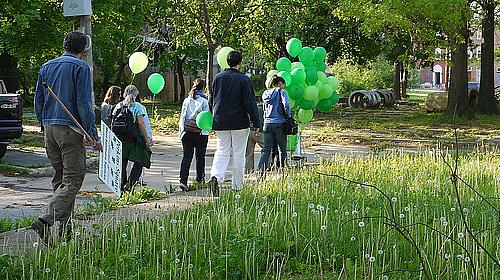Going Upstream: Tips for Finding Health Stories in the Built Environment

If your main sources on the health beat are physicians, you’re not doing your job.
That became clear over the course of Health and the Built Environment Webinar: What Makes a Healthy Environment?, presented by Center for Health Journalism Digital this week. The slides from the presentation are available on the website. And here are three tips I picked up.
Step outside the doctor’s office. WHYY’s Taunya English in Philadelphia said she had made a career of going to hospitals and clinics and interviewing doctors. The main sounds in her radio stories were ambulance sirens and the beeping of medical machinery. When she pushed herself to go beyond medical care to find health stories, she found what more and more reporters are finding: that the factors at play in the health of individuals and the health of communities are mostly outside what we think of as the traditional health care setting. Dr. Rishi Manchanda from HealthBegins in Los Angeles explained that what he and other doctors traditionally do has a relatively small impact on a person’s overall health. He talked about going upstream from the health care setting to look at the social determinants of health. When English did just that, she found city planners, transit designers, social workers, population health experts, housing advocates, and a range of other sources who could speak authoritatively on the factors that have an impact on health.
Analogize your story. When English stepped outside the doctor’s office, she also found a metaphor that helped her frame her series of stories – Designs on Health – before doing the bulk of her reporting. A source drew a picture of a rainstorm with three different types of people being pelted. One group had no umbrellas. Another group had their own umbrellas, which were providing a certain amount of protection. And a third group was a mix of people with their own umbrellas and no umbrellas but with everyone under a large umbrella. She decided to write about the big umbrellas: walkable cities, public transit, and health impact assessments (more on that later).
Ask, “Where do you live?” Manchanda said, “If doctors just asked that alone we would be better equipped to help people lead healthier lives.” I would add that reporters could ask that question more often, too. Manchanda gave the example of a woman who had gone to emergency rooms three times over a month for a chronic headache. She had been given two CAT scans and blood tests. After spending a lot of money and missing a lot of work, she was still sick. When she came to Manchanda’s clinic, though, she was asked about where she lived. His staff used questions from the American Housing Survey. “When I received the chart, I not only knew she had a headache and stable vital signs but key social data and within 12 minutes I was able to diagnose her,” Manchanda said. She had a housing-related illness driven by chronic allergies and migraine headaches triggered by mold and damp conditions in her home. Manchanda prescribed medication but he also brought in a team to help her make her home healthier. “Three months later, she came in and had not gone to any further emergency room visits,” Manchanda said. “Her symptoms were better. There were still some problems with mold, but it had abated significantly. She and her home were better. This is a better standard of care.”
On Monday, I’ll share my last three favorite tips from the webinar. Did you tune in? Do you have your own ideas to share? Send them to me at askantidote@gmail.com or via Twitter @wheisel.
Image by West Baltimore Squares via Flickr

